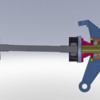Originally posted by PanteraDoug:
quote:
Originally posted by pantera chris:
It would be a oversimplification to say they forgot to grease the bearings, read the original post, removing the break rotors? not about that.
quote:
Originally posted by PanteraDoug:
Sounds like someone forgot to pack the bearings with grease.
I tend to agree with Bosswrench. Use the stock set up.
I would add that if you can remove your rear brake rotors without disassembling the rear uprights, there would be no reason to take them apart virtually ever.
It's on my list but I'm going with the rotor over the hub and not assembled behind it.
Hoy! I said there is no reason to disassemble the rears unless you need to cut your rotors. That can be fixed by going to a rotor and hat that sit over the exterior of the hub.
I'm not sure that the "on the car" rotor cutter will work back there with those drive axles, but maybe?
Irregardless. Doesn't matter. I do a lot of bearings. Some are loose, some are tight new. Has to do with the way they pack the grease in them.It really doesn't matter at all.
The design of the Pantera rear upright does not lend itself well to a non-sealed bearing.
The void that is normally occupied by the solid spacer from the factory is really too big to pack solid with bearing grease.
In addition, you have to disassemble (use a puller and press it back together) to do something simple like grease the bearings.
Therefore in my opinion at least, and that counts for diddly squat everywhere and even less around here, the rear bearings HAVE to be sealed bearing designs or nothing at all.
Failure of the bearing in the time period you have indicated and with the mileage normally put on these cars (you didn't put 50,000 miles on that bearing in one year did you), that is a lubrication issue.
If the bearing was set up too tight, the wheel wouldn't turn, you'd burn out the clutches in the ZF, and the engine clutch. That wheel would have dragged and the car would pull noticeably to one side.
If the bearing was too loose, it would have shown in the handling of the car and it would have rattled around like Hell back there.
Very unlikely the installation is wrong.



